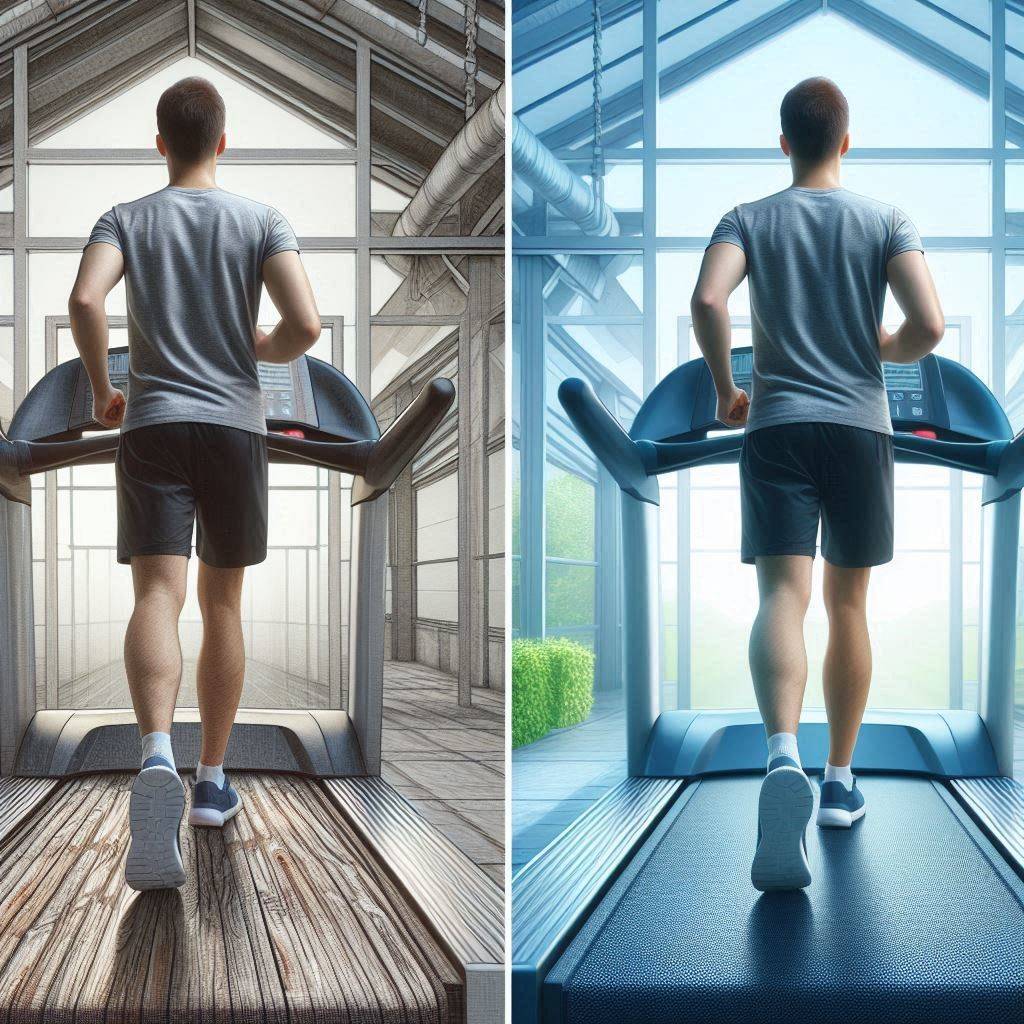Discover effective indoor walking exercise routines to boost your fitness at home. Learn techniques, benefits, and tips for maximizing your indoor workout results.
Quick Summary
Indoor walking exercise is an effective, accessible way to improve fitness at home. Key benefits:
- Improves cardiovascular health
- Burns calories for weight management
- Reduces stress and boosts mood
- Requires no special equipment
- Can be done anytime, regardless of the weather
Get started with a 10-minute daily walk and accumulate duration and intensity.
Introduction: Why Indoor Walking Exercise Matters?

As a fitness enthusiast who struggled with maintaining a consistent outdoor exercise routine, I discovered the power of home walking exercise. This simple yet effective workout has transformed my fitness journey, and I’m eager to share my experiences and insights with you.
The Science Behind Indoor Walking Exercise
Home walking exercise offers numerous health benefits backed by scientific research. Here’s what I’ve learned and experienced firsthand:
- Cardiovascular Health: Regular Home walking exercise improves heart health and lowers blood pressure.
- Weight Management: I’ve personally lost 15 pounds through consistent indoor walking.
- Mental Health: My stress levels have significantly decreased since starting this routine.
Getting Started with Indoor Walking Exercise
Essential Equipment
While Indoor Walk fitness requires minimal equipment, here are some items that have enhanced my experience:
- Comfortable shoes
- Fitness tracker (optional but helpful)
- Engaging audio content (podcasts, audiobooks, or music)
Creating Your Indoor Walking Space
I’ve transformed various areas of my home for indoor walking exercise. Here are some ideas:
- Living Room Circuit: I’ve mapped out a path around my furniture.
- Hallway Laps: successful for smaller spaces.
- Stair Stepping: If you have stairs, incorporate them for added intensity.
10 Effective Indoor Walking Exercise Routines
- Basic Walk in Place
- High Knee March
- Lateral Shuffles
- Heel-Toe Walk
- Backward Walking
- Zigzag Walk
- Arm Circle Walk
- Lunge Walk
- Interval Walking
- Walking Meditation
Maximizing Your Indoor Walking Exercise Results
Proper Form and Technique
Maintaining proper form during indoor walking fitness is crucial. Here’s what I focus on:
- Posture: Keep your head up, shoulders back, and core engaged.
- Arm Movement: Swing arms naturally to increase calorie burn.
- Foot Strike: Land heel to toe for a smooth gait.
Intensity and Duration
I’ve experimented with various intensities and durations. Here’s what works best:
- Beginners: Start with 10-15 minutes of moderate-paced walking.
- Intermediate: Aim for 30 minutes with interval training.
- Advanced: Try 45-60 minutes with varied routines and intensities.
Overcoming Indoor Walking Exercise Challenges
Boredom Busters
To keep my indoor walk fitness engaging, I use these strategies:
- Virtual Walking Tours: I use YouTube videos of scenic locations.
- Walking Games: I’ve created a step-based bingo game.
- Multitasking: I sometimes take work calls while walking.
Staying Motivated
Maintaining motivation for indoor walking exercise can be challenging. Here’s what keeps me going:
- Set achievable goals and track progress.
- Join online walking communities for support.
- Reward yourself for hitting milestones.
The Indoor Walking Exercise 28-Day Challenge
I’ve created a 28-day Indoor Walk fitness challenge based on my experience:
Week 1: 15 minutes daily,
Week 2: 20 minutes daily with interval training
Week 3: 25 minutes daily with a varied routine
Week 4: 30 minutes daily with combined techniques
Combining Indoor Walking Exercises with Other Workouts
To maximize fitness gains, I integrate home walking exercises with:
- Strength Training: I do bodyweight exercises during walking breaks.
- Flexibility Work: I incorporate stretching routines post-walk.
- Balance Training: I practice single-leg stands during walks.
Nutrition Tips to Complement Your Indoor Walking Exercise
Proper nutrition enhances the benefits of home walking exercise. Here’s my approach:
- Stay hydrated before, during, and after walks.
- Eat a light, balanced meal 1-2 hours before walking.
- Refuel with protein and complex carbs post-walk.
Tracking Progress and Celebrating Milestones
I use these methods to monitor my indoor walking exercise progress:
- Daily step count
- Weekly distance covered
- Monthly fitness assessments (e.g., resting heart rate, weight)
Indoor Walking Exercise: Quick Tips for Effective Workouts
After months of refining my indoor walking exercise routine, I’ve discovered several tricks that make a big difference. Here are my top tips to supercharge your indoor walks:
- Start with a Dynamic Warm-up
Before diving into your home walking exercise, spend 2-3 minutes doing these dynamic stretches:
- Arm circles
- Leg swings
- Torso twists
- Ankle rotations
- Use the “Talk Test” for Intensity
I’ve found the “talk test” to be a simple way to gauge Indoor walking fitness intensity:
- Moderate intensity: You can talk, but not sing
- Vigorous intensity: You can only say a few words at a time
- Incorporate Interval Training
To boost calories, burned during indoor walking exercise, I alternate between:
- 2 minutes of brisk walking
- 1 minute of fast-paced marching or jogging in place
Repeat this cycle 5-10 times for an effective workout.
- Add Upper Body Movements
Engage your arms during indoor walk fitness to increase overall calorie burn:
- Punch forward while walking
- Raise arms overhead every 10 steps
- Do arm circles while walking in place
- Use Household Items for Resistance
Spice up your indoor walking exercise with these household items:
- Water bottles as lightweights
- A broom for balance exercises
- A sturdy chair for support during leg lifts
- Create a Stimulating Environment
Enhance your indoor walking exercise experience with:
- A playlist of upbeat music
- Podcasts or audiobooks for longer sessions
- Nature sounds for a relaxing walk
- Set Mini-Challenges
Keep your indoor walking exercise exciting with these mini-challenges:
- Step count races: beat yesterday’s 10-minute step count
- “Commercial break” bursts: Walk as fast as you can during TV ad breaks
- Stair climb challenge: If you have stairs, see how many flights you can climb in 5 minutes
- Practice Mindful Walking
Turn your indoor walking exercise into a mindfulness session:
- Focus on your breath
- Pay attention to how your feet feel with each step
- Observe your posture and make micro-adjustments
- Cool Down and Stretch
Always end your indoor walking exercise with a proper cool-down:
- 2-3 minutes of slow walking
- Gentle stretches for calves, hamstrings, and quadriceps
- Track and Celebrate Progress
Stay motivated in your indoor walking exercise journey by:
- Logging your walks in a fitness app or journal
- Taking progress photos monthly
- Rewarding yourself for hitting milestones (I treat myself to a massage every 100 miles walked)
Bonus Tip: The “Room-to-Room” Challenge
One of my favourite ways to add variety to indoor walking exercises is the “Room-to-Room” challenge:
- Assign a different exercise to each room in your home
- Walk from room to room, performing the designated exercise in each
- Complete a full circuit of your home
For example:
- Living Room: 20 high knees
- Kitchen: 10 countertop push-ups
- Bedroom: 15 squat walks
- Bathroom: 30-second wall sit
By incorporating these quick tips into your indoor walking exercise routine, you’ll boost the effectiveness of your workouts and keep them fresh and exciting. Remember, consistency is key, and even minor improvements add up over time.
In my experience, these strategies have not only made my indoor walks more enjoyable but have also significantly improved my overall fitness.
Frequently Asked Questions
Are indoor walking workouts effective?
Yes, indoor walking exercise can be highly effective. It improves cardiovascular health, burns calories, and enhances overall fitness, especially when combined with varied intensities and movements.
Is walking in your house an exercise?
Absolutely. Indoor walking exercise at home can provide significant health benefits, including improved circulation, weight management, and stress reduction when done consistently and with proper form.
How to walk indoors to lose weight?
To lose weight with indoor walking exercise, increase intensity with intervals, incorporate stairs if available, add arm movements, and aim for at least 30 minutes daily. Combine with a balanced diet for optimal results.
Does the 28-day indoor walking challenge work?
The 28-day indoor walking exercise challenge can be effective if followed consistently. It helps establish a regular fitness routine, improves endurance, and can lead to noticeable health improvements when combined with proper nutrition.
Conclusion
Indoor walking exercise has been a significant change for my fitness journey. It’s accessible, effective, and adaptable to any lifestyle. By incorporating these techniques and tips, you too can boost your fitness without ever leaving home. Remember, consistency is key, and every step counts towards a healthier you.
Thank you for joining me on this indoor walking adventure. Here’s to your health and fitness success!
Recommended Reading:



